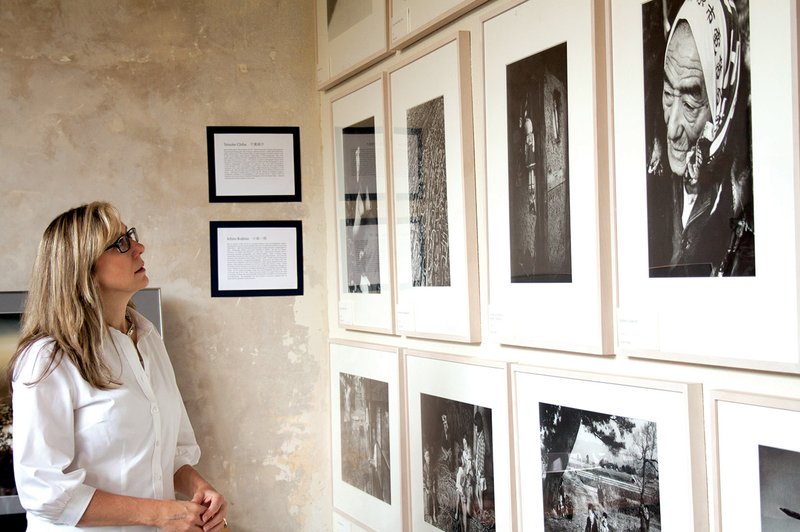On Friday night, visitors to the monthly Hot Springs Gallery Walk can come to a special outdoor Japanese tea room at Emergent Arts on Whittington Avenue. A tea service will be hosted by Garland County students who will travel to Japan in July as part of the Sister City youth exchange program. The high school students, from several school districts in the area, will be raising funds for their trips.
Through May 30, Emergent Arts is hosting a large cultural exhibition of photographs from Japan. Tohoku: Through the Eyes of Japanese Photographers is co-sponsored by the Hot Springs Sister City program, Emergent Arts and the Japanese Foundation, an organization dedicated to promoting international awareness and mutual understanding between Japan and the United States.
“The exhibit of more than 120 photographs, from the 1940s through the present day, shows the natural beauty of the Tohoku region, which includes Hot Springs’ Sister City of Hanamaki,” said Mary Neilson, director of the Sister City program in Hot Springs. “It is a major exhibition that normally would not come to a city this size. It is going to Denver after this.”
Neilson said the opportunity for the photographs to be displayed in the Spa City came from the Japanese Regional Consulate in Nashville.
“It was offered to us in a call from Nashville,” she said. “It was down to almost the last day as we searched for a place where we would display all these photographs.”
At a reception marking the opening of the display at Emergent Arts last Friday, Motohiko Kato, the Japanese consul for the region, talked about the photographs included in the exhibition.
“The region of Tohoku is very traditional,” Kato said, “and it is wonderful to capture that tradition in the photographs to share with our friends in the U.S. because the old ways of life are vanishing.”
The pictures range from large photographs of traditional masks, used for ceremonial and festive occasions, to mountain views and even the mists of the hot springs found near Hanamaki. Other photos show families or individuals during almost eight decades of Japanese life. The photos’ subject matter includes fishermen, hunters, dancers, and the young and old working or having fun.
As for helping to bring the exhibition to Hot Springs, Consul Kato said he wanted to give something to Hot Springs because of the cities’ special bond. He said the people of the United States, and especially Hot Springs, reached out to the residents of Hanamaki and the Tohoku region after a March 2011 earthquake and tsunami struck Japan and left 20,000 people dead or missing and caused a nuclear accident at the No. 1 Fukushima atomic power plant.
“The Hanamaki people will never forget the kindness and caring of the people of Hot Springs and the United States,” Kato said.
When the coast of Japan was hit by the fourth-largest earthquake in recorded history, Hanamaki felt the shock. The quake caused the city’s power station to explode, and the city was without power just as snow began to fall, according to reports from families who routinely hosted Hot Springs students and other Sister City visitors.
Although cold and in the dark for days, Hanamaki became a city of refuge for those whose homes were destroyed on the coast or were in danger from the nuclear-reactor crisis.
“Just as Hot Springs took in people from Hurricane Katrina, more than 1,000 people were evacuated to Hanamaki,” Neilson said. “After Katrina, when Hot Springs received evacuees from New Orleans, our friends in Hanamaki collected funds to assist those in need who came here. Schoolchildren raised more than $3,500 to assist the evacuees.”
In the weeks following Japan’s earthquake, more than $25,000 was collected by Hot Springs residents and sent to Hanamaki to assist those in need. There were bake sales, collections in schools and a benefit concert.
And all through the summer, Hot Springs-area teens signed up to visit Hanamaki that September.
“I admired the courage of the parents when the safe thing would have been to say they were not going,” Neilson said as she remembered the events of 2011. “After the State Department declared the area safe, we sent a full contingent of seven students, two chaperons and 10 other residents.”
In all, more than 50 people from both communities visited between the two cities. The first visitors from Hot Springs took 1,000 paper cranes to Japan. The crane is a Japanese symbol of peace and healing.
“We have enjoyed the Sister City relationship between Hot Springs and Hanamaki that has been going on for 20 years,” Kato said. “It is amazing. The youth exchanges widen the viewpoints on both sides. Those young people are building a bridge of understanding and friendship.”
For more information, contact Sister City Program Coordinator Mary Neilson at (501) 545-6960 or Erin at Emergent Arts at (501) 655-0836, or visit www.emergentarts.org.
Staff writer Wayne Bryan can be reached at (501) 244-4460 or wbryan@arkansasonline.com.
